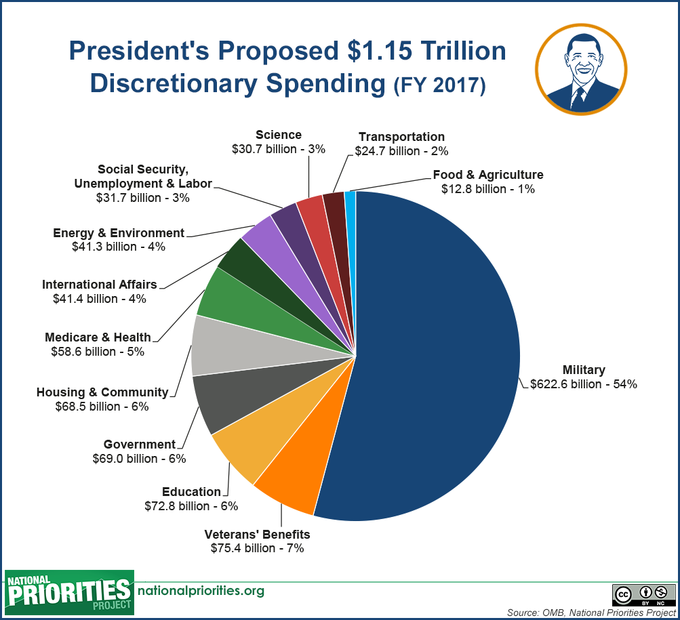The Ploughshares Fund tracks nuclear weapons production and spending in an effort to reduce and eliminate the ultimate weapons of mass destruction that like the sword of Damocles hangs above our collective heads. They currently estimate there are 15,375 with the vast majority in the hands of the U.S. (6,970) and Russia (7,300) and the remaining ones held by France (300), China (260), UK (215), Pakistan (130), India (120), Israel (80), N. Korea (<15).
Emeritus Professor of history, Dr. Lawrence Wittner, recently noted in an article on the History News Network, that
"Isn’t it rather odd that America’s largest single public expenditure scheduled for the coming decades has received no attention in the 2015-2016 presidential debates?"
The recent budget proposal from our Nobel peace Laureate President calls for $1 Trillion investment in nuclear weapons over the next thirty years. This expense likely means that other programs that support the well-being of the planet and the people we share it with will need to be reduced. Wittner goes on to gather what little clips of response to Obama's plan from the current field of presidential candidates he ca find. Some of whom might be a little to eager to use them - only China and India have declared a "no first use" policy.
In an earlier article this year on the Huffington Post, Wittner explains a bit how an early aim of President Obama to reduce nuclear weapons reduction has shifted 180 degrees.
Just yesterday, Prof. of International Law at the University Alabama, Dan Joyner discussed the hollowness of arguments to maintain such high numbers of weapons. On the Arms Control Wonk blog, Joyner discusses the legal gaps in law that some argue allow the first use of nuclear weapons under limited circumstance. The hollowness of those arguments along with the costs of developing and maintaining them make even holding them challengeable. In another recent analysis by the Union of Concerned Scientists, they call for a renewed stigmatization of nuclear weapons to be used against the nuclear club of nations.
And last week Greg Foster, a professor at the National Defense University, West Point graduate and decorated veteran of the Vietnam wrote a truly powerful critique of not only our nuclear weapons black hole but how civilian control of the military has become a fantasy and a crisis.
" The military remains the permanent keeper and executor of the world’s largest nuclear arsenal: an estimated 4,700 nuclear warheads on some 800 delivery systems, as well as another 2,340 “retired” but still intact and presumably usable warheads. A three-decade, trillion-dollar upgrade of this already monstrous arsenal is now underway. The Economist has called this Washington’s “unkicked addiction.” It should be clear, but apparently isn’t, that these are weapons of disuse. Other than for destroying the planet if used, their only value is as a measure of muscularity against mirror-image peers. They deter nothing at other levels of muscle-flexing but do feed an insatiable thirst for emulation among jealous non-possessors of such weaponry."
Foster goes on with a much larger critique including a long list of examples of what he calls the military's many failures of social responsibility. And it didn't even include the report in the Washington Post last week regarding the investigation of drug use by U.S. troops assigned to safeguard those weapons or by the decision of a president like Trump who show little hesitation to use nuclear weapons.
Joining Foster this week was another military man, retired Lieutenant Colonel and professor of history, William Astore, whose piece explores what he calls, "A Force Unto Itself."
"In the decades since the draft ended in 1973, a strange new military has emerged in the United States. Think of it, if you will, as a post-democratic force that prides itself on its warrior ethos rather than the old-fashioned citizen-soldier ideal. As such, it’s a military increasingly divorced from the people, with a way of life ever more foreign to most Americans (adulatory as they may feel toward its troops). Abroad, it’s now regularly put to purposes foreign to any traditional idea of national defense. In Washington, it has become a force unto itself, following its own priorities, pursuing its own agendas, increasingly unaccountable to either the president or Congress."
And of course, few are brave enough, with those above being the exception to the rule, to call this craziness out. There is enough pessimism in all this to send us all back to the sofa to watch NCAA basketball, crime based shows, or whatever we need to escape from the reality that these authors paint from experience, research and reflection. Our silence, to quote the title of MLK, Jr.'s most forceful critique of war, is betrayal.
Speaking of YOUR MONEY, it may seem a stretch, but entrepreneur Judy Wicks in a recent article Building a Local Peace Economy, articulates another approach to reclaim power we each could choose. It represents both an immediately available option, but a long slow change. The nuclear freeze movement brought people to the streets around the globe that helped shine a light on nuclear weapons to begin at least a scaling back. But with 15,000 loaded and ready to be used at the drop of a hat during these increasingly desperate and fearful times, we nudge closer to an event from which we may not escape. At a minimum we should vote this fall with this awareness at hand and judge our candidates for federal office by their positions on whether spending billions on weapons will make us and other residents of this planet any safer.
Now back to your regular program.




